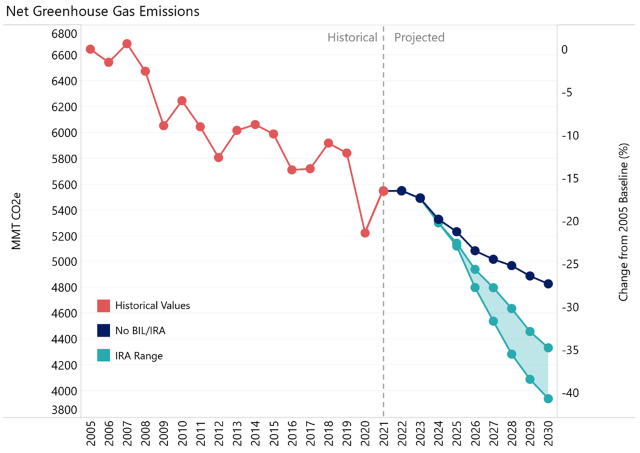Inflation Reduction Act and Bipartisan Infrastructure Law Analysis for the Department of Energy
OnLocation was asked by the U.S. Department of Energy’s Office of Policy (DOE OP) to develop and analyze three scenarios for the purpose of evaluating potential energy and environmental impacts of the Inflation Reduction Act of 2022 (IRA) and Bipartisan Infrastructure Law of 2021 (BIL). Analysis was performed using a customized version of the Energy Information Administration (EIA) National Energy Modeling System (NEMS), here referred to as “OP-NEMS.”
The BIL and IRA modeled provisions touch almost every energy sector, including the following:
- Power sector: new clean energy tax credits, zero-emission nuclear credit, and US Department of Agriculture (USDA) rural electric cooperative programs.
- Buildings sector: energy efficient home tax credits and rebate programs, and more stringent building codes.
- Transportation sector: clean vehicle tax credits and US Postal Service clean fleets, and clean buses.
- Refinery sector: extension of incentives for biofuels production.
- Industrial sector: carbon capture and storage (CCS) and electrification options for cement, steel, glass, paper, and aluminum production.
- Oil and gas production: royalty rate changes.
- Cross-cutting programs: extension of 45Q sequestration credits, hydrogen tax credits, US Environmental Protection Agency’s green bank program, and BIL funding for carbon capture demonstration plants and CO2 transport and storage infrastructure.
Three customized scenarios included: No BIL/IRA, Advanced BIL/IRA Implementation, and Moderate BIL/IRA Implementation. Scenario results show that IRA and BIL provisions make significant progress toward meeting climate mitigation targets, as shown below. Other benefits include greater energy efficiency in buildings, lower energy bills, and a shift toward cleaner energy sources such as renewables, electric vehicles, and carbon capture technologies.

OP-NEMS is based on the version of EIA NEMS used to produce the Annual Energy Outlook 2022 (AEO2022). OnLocation worked closely with the Office of Policy to create OP-NEMS and develop modeling assumptions for this analysis. An overview of the scenario results and assumptions was recently published by DOE OP.
The Advanced and Moderate baseline scenarios include key energy-related provisions of the BIL, IRA, and other recent policy updates such as Corporate Average Fuel Economy standards and state Zero Emission Vehicle standards. The scenarios ause alternative technology assumptions for power technologies and electric vehicles. Select assumptions differ between the two scenarios, with the Advanced scenario using higher uptake of IRA and BIL provisions and more optimistic technology assumptions compared to the Moderate scenario. For comparison purposes, the No BIL/IRA case includes all assumptions from the Moderate case but excludes IRA and BIL provisions. Note that the BIL and IRA representations in OP-NEMS are more comprehensive than the AEO 2023 representations. For more information about these differences, see the Technical Appendix.
All three scenarios reflect additional model enhancements developed by OnLocation with the DOE Office of Fossil Energy and Carbon Management (FECM) including expanded representation of industrial carbon capture technologies and biomass cofiring in power plants that are not represented in EIA NEMS.
In addition to the NEMS customization and application above, OnLocation has created customized versions of the NEMS model for many other clients and implemented IRA and BIL provisions using client-specific policy and technology assumptions. Since its inception in 1984, OnLocation has been performing integrated modeling for government and private clients to analyze all aspects of the energy system.

